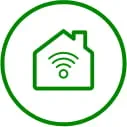If fiber construction is planned for your neighborhood, you may have questions about utility easements and what they mean for your property. No worries — we're here to set the record straight. Understanding utility easements, why they're necessary and how they impact your property during construction will help make the whole process smoother. While utility easements allow service providers to access certain areas for infrastructure, it's important to know that right of way is managed by a municipal agency and does not exist on privately owned property. Utility easements don't overlap right of way but are often adjacent to and abutting it, which can clarify where construction may take place and what to expect. Let's take a look at everything you need to know.
What is a utility easement?
Simply put, a utility easement is a legal right for utility companies,
like Ziply Fiber, to access certain areas of private property for
installing, maintaining or repairing infrastructure — like fiber-optic
cables. Easements help make sure essential services like water, power or
internet are easily accessible in your area, and they're a key part of
how fiber internet networks are built. Without easements, it would be
much harder to provide services to your home and neighborhood, not to
mention a lot more expensive. They're the reason you can get fast,
reliable fiber internet and other utilities where you live.

Common locations of easements
Utility easements can be found in a few different places on your property, and understanding where they are helps make construction go smoothly. These are some of the most common spots where easements might exist:
- Front yard areas: Often, fiber-optic lines are placed in the front of your property, close to the sidewalk or street, for easy access. Typical easement widths range from 5 feet in width to 10 feet in width.
- Side yard access: Easements may run along the side of your property — this is a great place for utility lines because they're less disruptive to your lawn and landscaping.
- Backyard utilities: In some cases, easements can extend into your backyard, especially if underground lines are needed in the area.
- Street-facing zones: Easements may be near the street or sidewalk where utilities can easily be connected to your home.
It's a common misconception that once an easement is granted, utility companies can do whatever they want with your property, but that's not the case. Even though a utility company has rights to use parts of your property, you retain ownership. Any work done should only affect the easement area, and utility companies are required to follow guidelines to protect your property and restore it to equal or better condition after work is completed. While use of public utility easements does not require approval from the property owner, Ziply Fiber notifies customers with door hangers of our intentions to work in these areas.
Types of easements
- Public utility easements: These easements allow utilities like water, power or fiber-optic networks to be installed and maintained on private property.
- Rights-of-way: This type of easement grants access to a designated path where utility lines can be placed, usually along roads or sidewalks.
- Maintenance access: These easements allow utility workers to access the area in order to maintain or repair equipment when necessary.
- Construction zones: These are temporary easements granted specifically for construction work, typically only during the installation phase.

How to identify easements
- Property documents: Your property deed or official records will mention any easements that apply to your land. These documents are public record and can be found at the County Recorder's Office; they may also be available online.
- Survey markers: If a survey has been done on your property, you may find markers indicating the boundaries of easements.
- Utility indicators: Look for flags, markers or signs from the utility company that indicate the presence of an easement.
- Public records: Your local government may have public records showing where easements are located on your property.

Fiber-optic construction in easement areas
Underground excavation
Construction workers will dig trenches to lay the fiber-optic cables underground.
Utility placement
Fiber-optic cables and necessary equipment will be carefully placed according to the plans.
- Access requirements: Workers may need access to specific parts of your property to complete the job, so make sure those areas are clear of obstacles.
Equipment used
- Excavators: Used for digging trenches.
- Trenchers: Used to help place the cables underground.
- Other machinery: To assist in clearing areas or moving materials.
Timeline expectations
Fiber internet construction typically takes anywhere from a few days to a few weeks, depending on the scope of the project. We'll keep you updated on the estimated timeline, so you know what to expect.
Safety measures
The safety of workers and property owners is top priority. Expect safety barriers and signage around the construction area, and our workers will wear protective gear to ensure a safe environment.
Restoration process
- Soil replacement: Any soil displaced during construction will be put back and compacted accordingly, with any excess being hauled away.
- Grass reseeding: If your lawn is affected, it will be reseeded so it can grow back quickly.
- Cleanup procedures: Crews will ensure the area is cleaned up, leaving your yard looking as it did before.
- Final inspection: A final inspection will ensure the restoration work was done properly.
Homeowner information
- No need to be present: You won't need to be home for the work to happen unless there's special access required to your property.
- Notification process: Before any work begins, we'll notify you about the construction timeline and what areas will be impacted, and you'll be kept in the loop about any changes.
- Contact information: You can reach the Ziply Fiber construction team by calling 1-855-950-0779 if you have any questions or concerns, or, visit the construction quality website: https://ziplyfiber.com/construction-feedback.
Property preparation
- Marking private utilities: Some utilities are not locatable, so we may need your help. If you have private utilities (like sprinkler systems or electrical lines), be sure to mark them so they don't get accidentally damaged. If, in the unfortunate circumstance there is damage to an unlocatable utility, we will complete all needed repairs at our cost.
- Removing obstacles: Clear the work areas of any obstacles like garden decorations, furniture or outdoor play equipment to give workers easy access.
- Securing pets: Keep pets safe by securing them away from the construction area. It's always best to keep animals indoors while work is underway.
Communication process
- Before construction: You'll be notified of the upcoming work with plenty of time to prepare. We'll also give you a timeline, and you'll have the chance to ask any questions.
- Emergency contacts: If something urgent comes up, you can speak with an onsite inspector during construction or call 1-855-950-0779 to resolve any problems quickly.
Common questions
- Damage prevention: Will my property be damaged? Any work performed will be focused on the easement areas, and we'll restore everything to its original condition. If something isn't restored properly, let us know, and we'll make it right.
- Timeline estimates: How long will construction take? The timeline depends on the scope of the project, but we'll keep you updated with any changes.
- Access requirements: Will you need to access my entire yard? Typically, access is limited to the easement area, but we'll let you know in advance if we need to enter other parts of your property.
What to expect during the construction process
- Work hours: Most of the work will take place during regular business hours, with occasional flexibility for urgent tasks.
- Noise levels: We will abide by all noise restriction ordinances set forth by the governing municipality.
- Safety measures: We'll take all necessary safety precautions to ensure everyone is protected. However, if you see something that concerns you, please call us directly at 1-855-950-0779.
- Weather impacts: Weather can sometimes delay the schedule, but we'll keep you posted if anything changes.
What happens next?
- Post-construction: After everything's done, a final inspection will be conducted to ensure everything is in place and working properly.
- Property restoration: Your property will be restored to its original state, with any landscaping and lawn areas treated to ensure they bounce back beautifully.
- Service activation: Once the restoration is complete, your Ziply Fiber service will be activated, and you can enjoy all the benefits of fast, reliable fiber internet.
- Follow-up process: After everything's finished, we may check in to ensure everything is still in good condition. If any issues come up, we'll be here to help. Just call us at 1-855-950-0779.
Fast, reliable fiber internet is on the way
We know that fiber internet construction can bring up a lot of questions, but our goal is to make the process as smooth and hassle-free as possible. With clear communication, careful planning and a commitment to restoring your property, Ziply Fiber is here to ensure that bringing fiber internet to your neighborhood is a positive experience. If you have any questions along the way, we're always happy to help.






